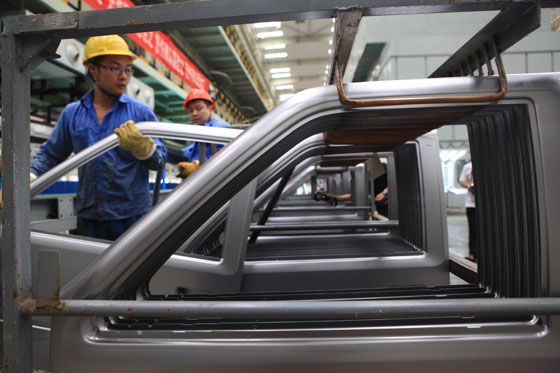
Automobile production in future without any Chinese partners?
The plan goes through 2025, and outlines everything from goals for new energy vehicles (NEV) to mineral acquisitions. What is most interesting to foreign carmakers is that the government will “open up the restriction on joint venture ownership in an orderly manner.” Currently, there is a 50% cap on how much of a joint venture a foreign company can own, known as the ‘50-50 rule’. No timeline or specifics were released on how this policy will be rolled back. While there was talk as early as 2013 of easing foreign ownership restrictions, the twin combination of environmental goals and tensions with the US administration over trade barriers seems to have given it a push.
History of the Chinese auto industry
China’s automobile industry traces its roots back to 1953, with the founding of the First Automotive Works Group (FAW). Today, China is both the world’s largest car manufacturers and auto market. China boasts over 100 different car brands, organised into three categories: foreign brands (like Volkswagen), local Chinese brands (Beijing Automotive Group), and sub-brands made up of joint ventures between Chinese and foreign companies (SAIC-GM).
While foreign brands have thrived in China, domestic brands have struggled. A record number of cars were sold in China in 2016, 23.9 million, but less than half of them were from wholly domestic companies. Foreign companies have a market share of roughly 64%, and have continued to drive the growth of Chinese car makers. The three largest state-owned car manufacturers by sales, Shanghai General Motors Company, Dongfeng, and Guangzhou Automobile Group, together earned $7.7 billion in 2016. Yet most of that was due to sales of foreign brands to middle-class consumers. Their own brands are unknown outside of China, and even within China, are seen as inferior to foreign brands.
While Chinese car manufacturers may not be well known outside China, they have been investing in foreign markets. In 2010, a Chinese car manufacturer, Geely Holdings Group Co. Ltd., bought out Ford’s Volvo unit for nearly $2 billion dollars. While most international consumers are still not familiar with Chinese brands, they have invested billions in most major car manufacturers.
What is the ‘50-50 rule’?
During the 1980s, China first allowed foreign car manufacturers to enter the Chinese market by forming joint ventures with Chinese companies. This policy capped foreign ownership at 50%, allowing local brands time to develop and gain access to foreign technology and experience (and of course foreign money), while foreign companies gained access to the Chinese market (since their imports are subject to a massive tariff). This deal has worked out very well for Chinese car manufacturers, who earned $67 billion yuan ($9.7 billion USD, €8.6 billion euros) in 2014 alone.
In addition to the ‘50-50 rule’, China has attempted to encourage domestic car purchases with a 25% tariff on all imported vehicles. This further incentivised foreign car manufacturers to create Chinese production plants. There is currently no talk of removing this tariff in the near future.
 The industrial plan passed in 2017 for China’s car industry, which borrows heavily from the German strategic initiative Industrie 4.0, is highly ambitious. It could mark the start of a spurt of growth in the Chinese manufacturing industry.
The industrial plan passed in 2017 for China’s car industry, which borrows heavily from the German strategic initiative Industrie 4.0, is highly ambitious. It could mark the start of a spurt of growth in the Chinese manufacturing industry.
How do joint ventures work?
Volkswagen was the first car company to make significant investments in China, and was also the first to form a joint venture with a Chinese company. Previously, most companies opted to export a small number of cars to China and wait for the market to develop. Volkswagen instead created factories in China through a joint venture. In 1984 Volkswagen launched a joint venture with the Shanghai Automotive Industry (SAIC), forming the “SAIC Volkswagen Automotive Company Limited.” In 1985, they produced their first joint model, the “Santana”. In 1988 Volkswagen created its second joint venture with First Automotive Works (FAW), to produce the Audi 100 in China.
Both joint ventures followed the ‘50-50 rule’. It is easy to see why virtually every major car producer soon followed Volkswagen’s model; by 1995 Volkswagen had captured approximately 70% of the Chinese market. Many of their initial (and most important) customers were government bodies, such as the city of Shanghai, which had Volkswagen provide the city’s taxis.
In 2004 “The Volkswagen Group China” was officially formed, with around 95,000 employees in 20 factories, and with two more planned to open by 2018. While Volkswagen enjoyed a significant “first-mover” advantage, that advantage has eroded in recent years. While Volkswagen still has brand loyalty, in 2010 Volkswagen, though still the leading car company in China, only controlled about 20% of the market.
Short and long-term impact and implication of foreign-owned shares greater than 50%
The reaction has been mixed. Most Chinese car manufacturers saw their shares rise due to speculation that they may soon sell their shares to their foreign partners. Foreign car makers, no longer forced into joint ventures, could potentially make (some would say recover) the billions their partners currently make from the partnership. As the announcement stressed however, the end of the ‘50-50 rule’ will happen in an “orderly manner,” and may not begin for several years. It will also take years for the joint ventures to disentangle themselves. As expected, many Chinese car manufacturers are not thrilled by this developing, fearing that strong foreign partners in joint venture may insist on a bigger share.”
Reform part of larger China 2025 plan
The recent reforms the Chinese car industry has seen are just one part of a plan known as “Made in China 2025.” Announced in 2015 and based on Germany’s strategic initiative “Industrie 4.0,” it is China’s attempt to move towards more high-tech manufacturing, according to Ecovis’ team of experts. While the state will continue to play a key role in the Chinese economy, “Made in China 2025” is meant to utilise market institutions and local innovation. As part of that, many industries will see major reforms. The car industry was named as one of the ten key industries that China hopes to compete globally in.
A key part of that plan is new energy vehicles (NEVs). China’s goals are for 20% of all car sales by 2025, 7 million vehicles in total, to be new energy vehicles. China has made a major push to acquire this technology, actively asking foreign car makers with new energy vehicle technology to share it with their Chinese partners in exchange for increased market access in China.
Another key part of the “Made in China 2025” initiative is for Chinese companies to become more efficient, for example by helping to fund Chinese acquisitions of the foreign industries and mines necessary to create the new energy vehicle revolution in China.
Ecovis’ assessment
China remains a dynamic market, where reform can be stalled for years, only to leap forward suddenly in a matter of months. While several Chinese agencies have claimed that the ‘50-50 rule’ will be lifted by 2025, it could be several years before any reform occurs, because no timeline was laid out. It is also unclear what the reforms will look like. Will the new ratio be 75-25, or the joint venture requirements be totally removed? Ecovis will continue to monitor the situation, and inform our clients if and when anything significant occurs.
The April meeting between President Trump and President Xi that may have contributed to this reform may soon lead to more. Presidents Trump and Xi created a “100-Day Plan” designed to decrease the current trade imbalance between America and China. It is possible that the near future will see more restrictions on foreign investment in China being lifted.
Production of cars and commercial vehicles in China
| year | millions (rounded) | percentage growth compared to prior year |
| 2016 | 28.1 | 14.5 |
| 2015 | 24.5 | 3.3 |
| 2014 | 23.7 | 7.3 |
| 2013 | 22.1 | 14.8 |
| 2012 | 19.3 | 4.6 |
Source: Organisation Internationale des Constructeurs d’Automobiles (OICA)
 Author:
Author:
Richard Hoffmann
Contact us:
ECOVIS European China desk
Wallstadter Str. 5968526 Ladenburg
Phone: +49 6203 95561 2602
www.ecovis.com/heidelberg

